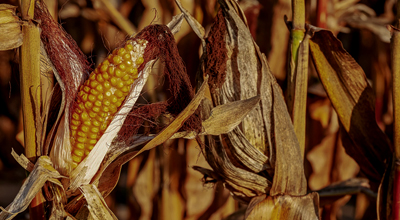
Image: Pixabay
Climate, leafhopper, diseases and cultural practices. All of this affected 1st harvest corn in southern Brazil. According to estimates from the National Supply Company (CONAB), production in the region should show a drop of at least 8%. In the 2019/20 harvest, the three southern states harvested 10,249 million tons. This year, they should not exceed 9,408 million tons.
Surveys carried out in the most affected regions detected poor ear formation, multiple ears, abnormal matting, necrosis at the base and along the ears, premature death of the ears and lower grain weight. Many areas also showed tipping over and premature death of plants.
Because of this scenario, producers in the region fear that they will not be able to honor contracts with trading companies and cooperatives simply because there is no corn available to be delivered. The international price of the commodity encouraged an increase in the area planted with the grain and a large part of the 2021 production was sold in advance due to the favorable exchange rate. Internally, the country is experiencing a shortage due to the enormous volume exported last year.
Among experts, there is a consensus that the problems resulted from a combination of factors. Regarding the climate, drought in winter, late frosts and excess rain in summer caused losses and favored the spread of pests and diseases, especially in the southwest of Paraná, west of Santa Catarina and also in a large part of Rio Grande do Sul .
Influence of La Niña
“In 2020, Brazil was under the influence of the La Niña climate phenomenon, which cools the water of the Pacific Ocean and, among other consequences, interferes with the rainfall regime”, explains Desirée Brandt, meteorologist at Somar Meteorologia.
“This phenomenon usually causes drought in the South. Between August and November 2020, in the three states of the region, rainfall was 50% below the average for the period”, says Desirée.
The drought delayed sowing and extended the planting window in some regions. The lack of rain also caused an increase in temperatures, favoring the multiplication of pests, such as the corn leafhopper, a vector of three diseases that are harmful to corn crops: corn stripe (rayado fine virus), pale stunt and red stunt. The last two are caused by microorganisms called mollicutes.
The manifestation of the symptoms of the stunting complex occurred in different intensities. It was more severe in some areas of Santa Catarina (West, Midwest and Planalto Norte) and in Paraná and milder in Rio Grande do Sul.
“As leafhoppers have a preference for young plants, as soon as the corn germinates it is attacked by the pest which, if it carries the virus or mollicutes, will transmit the diseases”, says phytopathologist Ricardo Trezzi Casa, professor at the State University of Santa Catarina (UDESC).
In December, rain fell heavily in the south of the country, mainly in the central parts of Rio Grande do Sul and Santa Catarina. The hot and humid weather brought more problems for corn. The incidence of fungi and bacteria has increased, explains Casa. Fusarium wilt, anthracnose and diplodia spot were some of the diseases that emerged. As a consequence, there was also an increase in cases of stem, root and ear rot.
{module Form RD}
To avoid failures in future harvests, the following actions are
recommended:
– Seed treatment;
– Crop rotation;
– Elimination and control of wild and invasive plants that can harbor pests and diseases;
– Monitoring of pests and diseases, which allows control whenever necessary and at the right time;
– Use of agricultural pesticides registered for the crop, pest and/or disease and in the doses indicated for each target, in accordance with the guidelines contained in the leaflets;
– Choice of cultivars suitable for each region, considering the greater or lesser susceptibility to pests and diseases existing in that location;
– Use of appropriate planting densities;
– Definition of the sowing window taking into account the Agricultural Climate Risk Zoning;
– Balanced nutritional management.
– Creation of regional monitoring systems for pests and diseases;
“We need strategies to balance and produce more sustainably”, says Ivan Cruz, researcher at Embrapa Milho e Sorgo and doctor in integrated pest management. “It is necessary to plan and think about systems in an integrated way, considering all the crops planted throughout the year”, he adds.
* With information from CropLife Brasil
By: Eliza Maliszewski | agrolink












